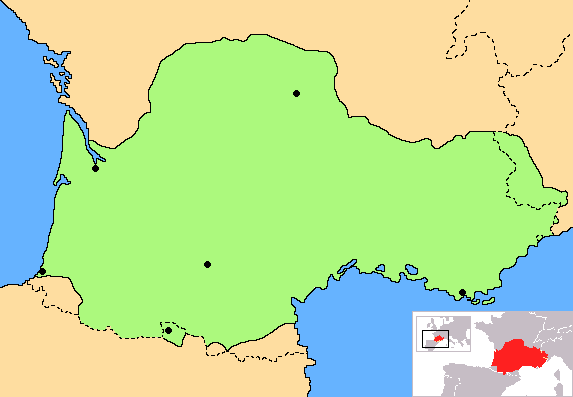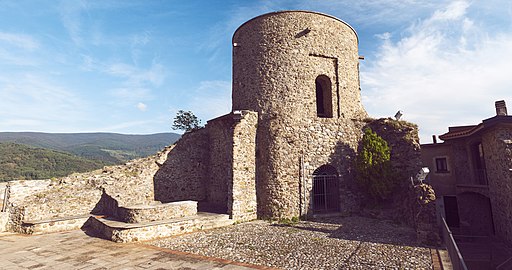Language  |
Beauty & a key
to knowledge |
-
- Wikipedia article
text
text
text
text
Introduction
It was strange to find Ligurian being spoken in southern Sardinia, but it is even stranger to find a Gallo-Romance language being spoken in Calabria, just north of the toe of mainland Italy.  |
Sign at entrance to Guardia Piemontese
(Photo: Jfblanc at Occitan Wikipedia) |
The people who brought it here were actually from an area now in Italy, although only just, and their story is one of religious persecution. The name of the town contains a clue to their origin, for they came to Calabria from Piedmont, in the north-west of Italy, and although they arrived many hundreds of years ago, they have continued to speak their own language. This is a variety of Occitan, a language distinct from the Gallo-Italian of areas neighbouring their original home and even more distinct from the Neapolitan and Sicilian speech of their present-day neighbours.
Occitan
 |
Map showing the extent of Occitan
(By Norrin strange at Wikimedia Commons) |
The Occitan language evolved in southern Gaul at the same time as French was evolving further north. The southern language survives in numerous localities, although standard French is now used by a great many more speakers in the south. Occitan spills over the border into a tiny area of the Spanish Pyrenees, the Val d'Aran, and also over the Italian border into the western part of Piedmont. There are several dialects of Occitan, but the one spoken in Piedmont is known as Vivaro-Alpine.[1][2]
Notes - Dialects of Occitan
- Gascon, including Béarnese, and also Aranese (spoken in Spain)
- Languedocien (lengadocian)
- Limousin (lemosin)
- Auvergnat (auvernhat)
- Provençal (provençau or prouvençau), including the Niçard subdialect[a]
- Provençal includes the Shuadit language (Judæo-Occitan)
- Vivaro-Alpine (vivaroaupenc), also known as "Alpine" or "Alpine Provençal",
and sometimes considered a subdialect of Provençal
- On some maps a dialect called roiasco is also shown, but this is generally regarded as a variety of Ligurian. It is known as Royasc in English and if you are particularly interested, there is an article
about it on Wikipedia.
The Waldensians
 |
1868 statue of Peter Waldo at the Luther Memorial
in Worms, Germany
(Photo: Alexander Hoernigk at Wikimedia Commons) |
The Waldensian movement was founded by Peter Waldo in the 12th century and, although Christians, its members were regarded as heretics by the Catholic Church. At the time of the Reformation they became part of the broad Protestant movement and the Waldensian Evangelical Church continued in Italy until 1975, when it merged with the Methodist Evangelical Church to form the Union of Methodist and Waldensian Churches.
During the 12th and 13th centuries Waldensians from the areas of Bobbio Pellice and Torre Pellice in western Piedmont fled to Calabria from persecution by the Inquisition. For a long time they lay low, practising Catholicism in public, but secretly retaining their Waldensian beliefs. However, with the advent of the Reformation, they became more open about their religious convictions, but their new boldness eventually led to the suppression of the Waldensian movement in the area. This was particularly violent in the town now known as Guardia Piemontese. (See fuller details below.)
Guardia Piemontese
Guardia Piemontese in on the west coast of northern Calabria. The first element of the name probably refers to a watchtower built in the 11th century to keep a lookout for Arab pirates. The name of the town has changed several times and the present one, dating from the 19th century, reflects the origin of its inhabitants.  |
The tower which gave Guardia Piemontese its name
(Photo: Emanuele Santoro at Wikimedia Commons) |
By the late 14th century there were Waldensians living on the site and the town has remained in existence and retained its Occitan speech. The Waldensians lived as Catholics, while retaining their beliefs, until the Reformation, when they became bolder. In 1532 they decided to practise their faith openly, but by the 1560s this had become intolerable to the authorities, who regarded them as heretics. Threats proved ineffective and Waldensians from the surrounding area fled to Guardia, which was fortified. In June 1561 the local overlord, unwilling to be seen as supporting heretics, used a Trojan Horse subterfuge to gain entry to the town and many Waldensians were murdered. This event is commemorated in the name of the town's main gate, the Porta del Sangue, or Gate of Blood. Survivors were forced to convert to Catholicism and were subjected to a harsh regime, which included the use of spioncini, spyholes which could be opened from the outside, installed in the town's front doors. Apparently, some of these can still be found.
The Gardiòl dialect
Despite the suppression of their religion, the people of Guardia, or La Gàrdia, as they call it, have continued to use their distinct Occitan dialect. Not surprisingly, it has been influenced by the speech of their neighbours in Calabria. For example, Gardiòl has adopted the use of retroflex consonants, common in Sicily and southern Italy. I notice too that the practice of replacing l after an initial consonant with yod has infiltrated the dialect. Occitan generally retains the l or replaces it with a palatal lateral.
Here is a link to a table comparing the dialect with various other Romance languages which I took from Occitan Wikipedia and doctored a little:
Table comparing Gardiòl with other Romance languages
This is a link to a recording of people speaking Gardiòl:
YouTube recording
Note
- Posted May 2017